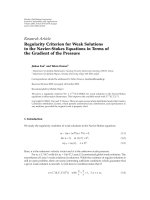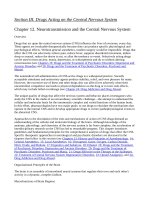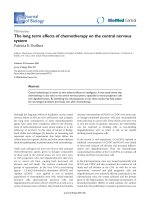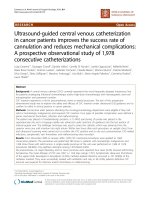Central Venous Pressure docx
Bạn đang xem bản rút gọn của tài liệu. Xem và tải ngay bản đầy đủ của tài liệu tại đây (99.17 KB, 5 trang )
Central Venous Pressure
Central venous pressure is defined as the pressure of blood in the central venous
system which is essentially just prior to entry into the right atrium.
This is the point where the superior vena cava meets the inferior vena cava
prior to entry into the right atrium of the heart. It is usually measured by
placing a catheter in one of the veins and then threading it to this point. This
procedure is usually done under aseptic techniques in a ward, operating theatre, or
the intensive care unit of a well equipped and staffed hospital. A qualified medical
practitioner is authorised to perform this procedure.
In normal health the amount of blood coming to the heart is balanced precisely by
the amount of blood leaving the heart. The cardiovascular system will be viewed
as a closed system for the purposed of this discussion. When there is blood loss or
other alteration in the cardiovascular system's homeostatic mechanism it will first
be reflected in changes of the venous pressure at this point. As a rule of thumb the
central venous pressure is a good indicator of the amount of blood returning to
the heart from the systemic circulation. Further, it (CVP) is a good indicator of
the pumping ability of the right atrium and the right ventricle. When the right
atrium or ventricle is failing (e.g. following right atrial or ventricular MI) the CVP
will be one of the first indicators to rise. The rising CVP indicates that the atria
and/or ventricle are failing.
Normal CVP values.
In homeostasis CVP is from 0 to 8 cm of water (5 to 10 cm of water is also
normal) or 2 to 6 mm of mercury
Conditions which cause the CVP to rise.
Several conditions can cause the CVP to rise. Some situations which cause the
CVP to rise are as follows:
1. Increased intra thoracic pressure will cause the CVP to be higher than
normal. This will happen when a patient has been intubated and is being ventilated
artificially.
2. Whenever there is impaired cardiac function (right sided heart failure,
tamponade) the CVP will rise
3. Hypervolemia happens when a patient has been given an excess amount of IV
fluids. This will cause the CVP to rise. It is for this reason that physicians often
prescribe fruosemide to patients when giving packed red blood cells. The RBCs
increase circulating volume and the fruosemide decreases it. Homeostasis is
maintained.
4. Obstruction of the superior vena cava will cause the CVP to rise
5. Pulmonary artery stenosis which limit venous outflow and lead to venous
congestion cause the CVP to rise
6. Straining, forced exhalation, tension pneumothorax and pleural effusion
will cause CVP to rise
Conditions which cause the CVP to decrease.
Some conditions will cause the CVP to fall. Stated below are some conditions
which will cause the CVP to fall.
1. Hypovolemia is a decrease in circulating volume. These conditions include
blood loss and excessive diuresis.
2. Reduced intra thoracic pressure as seen during inspiration
Keywords:
- pressure of blood in the central venous system: áp lực máu tại hệ thống tĩnh
mạch trung tâm.
- the point where the superior vena cava meets the inferior vena cava prior to entry
into the right atrium of the heart: nơi mà tĩnh mạch chủ trên và tĩnh mạch chủ dưới
giao nhau và cùng đi vào nhĩ phải.
- indicator of the amount of blood returning to the heart: thể hiện lượng máu trở về
tim.
- Indicator of the pumping ability of the right atrium and the right ventricle: thể
hiện khả năng bơm máu của nhĩ và thất phải.
To summarize:
- CVP là:
Áp lực máu tại hệ thống tĩnh mạch trung tâm (nơi tĩnh mạch chủ trên và tĩnh mạch
chủ dưới giao nhau và cùng đi vào nhĩ phải).
- Giúp xác định:
- Lượng máu trở về tim
- Khả năng bơm máu của nhĩ và thất phải.
- Bình thường khi : 0-8cm nước/ 2-6 mm Hg.
- Tăng khi:
- Tăng áp lực lồng ngực.
- Suy giảm chức năng tim
- Tăng lưu lượng tùân hoàn
- Tắc tĩnh mạch chủ trên
- Hẹp động mạch phổi
- Các nguyên nhân gây tăng áp lực tại phổi.
- Giảm khi:
- Giảm lưu lượng tùân hoàn
- Giảm áp lực lồng ngực.









